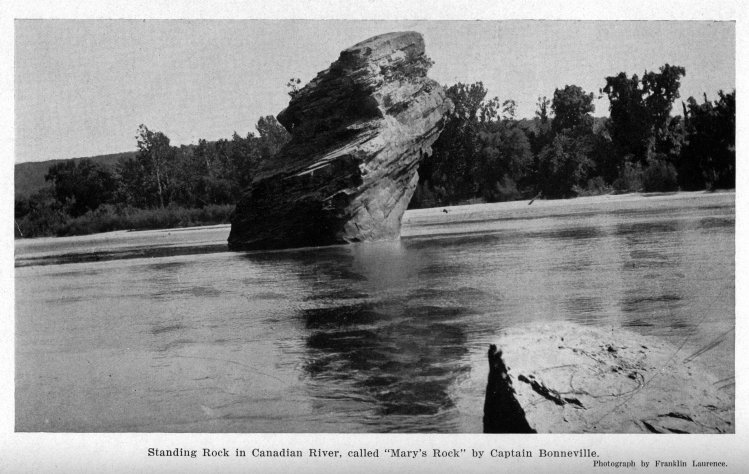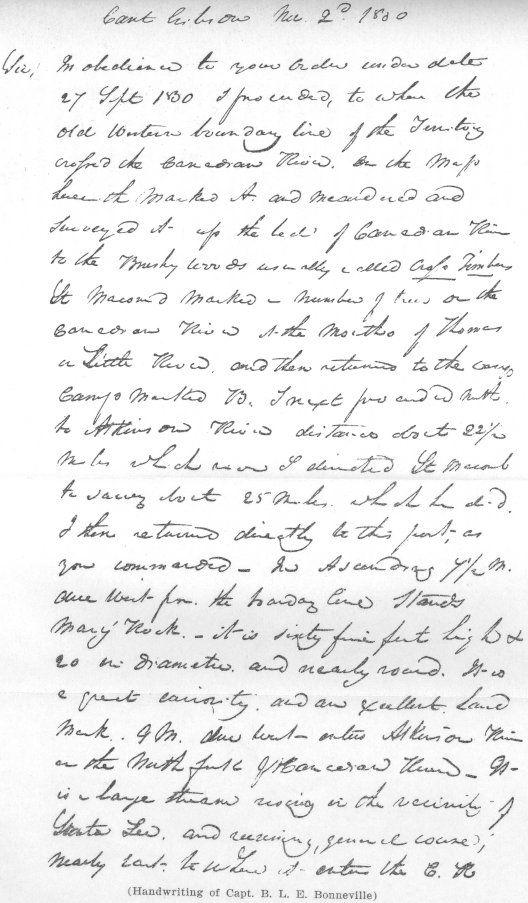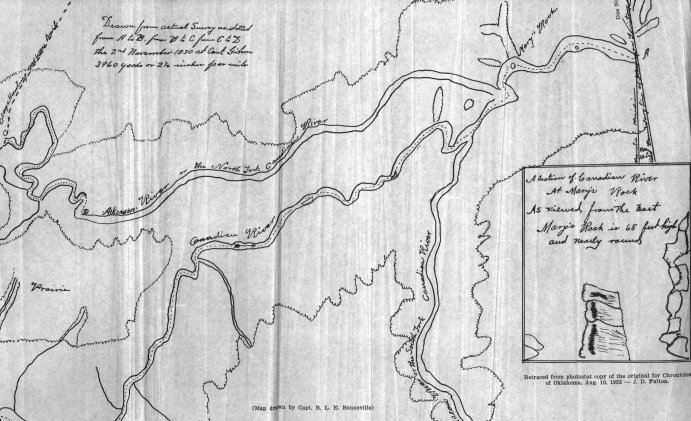Chronicles of Oklahoma
Volume 10, No.
3
September, 1932
AN UNPUBLISHED REPORT BY CAPTAIN BONNEVILLE WITH
INTRODUCTION AND FOOTNOTES
By Grant Foreman
Benjamin Louis Eulalie de Bonneville was born in France in 1793 the son of a newspaper editor who was an intimate friend of General Lafayette. The family won disfavor because of editorial statements denouncing Bonaparte as a Cromwell of France and they were exiled to America. The son attended the United States Military Academy and was graduated December 11, 1815. As second lieutenant in the army he served in northeastern posts until 1819 and from that time to 1820 was engaged on the construction of a military road through Mississippi and in the garrison at the Bay of St. Louis, Mississippi. He was promoted to first lieutenant in the Eighth Infantry July 9, 1820 and in the reorganization of the army became first lieutenant in the Seventh Infantry, serving at Fort Smith from 1822 to 1824 and then upon the abandonment of Fort Smith he accompanied his regiment to Fort Gibson where he served until the next year. He then secured leave of absence and went to New York to become secretary to General Lafayette on his return to Europe. After this service he returned to Fort Gibson where he served from 1826 to 1828.
Here Bonneville learned from returning travelers and traders much of the romance of the unknown country to the west and as a result formed the plan of heading an expedition to the Rocky Mountains. For this purpose he secured a leave of absence and left Fort Gibson in 1830. He then secured financial backing in New York and on July 29, 1830 secured another leave from the War Department for two years. The following May with a company of one hundred ten men including experienced hunters and trappers and twenty ox and mule wagons loaded with supplies, ammunition and merchandise to trade with the Indians, he started on his journey. He did not return within the limits fixed by his leave and as a result his name was dropped from the army rolls on May 31,

1834. It was nearly fifteen months after that time that he reached Independence, Missouri, from his western trip and continued to New York and Washington where he brought pressure to bear for reinstatement in the army. In this he was successful and an order was made restoring him in the army and giving him the rank of captain of the Seventh infantry as of October 4, 1825. He then returned to his regiment at Fort Gibson.
During his absence Captain Bonneville accumulated a large amount of information much of which he preserved in written notes and descriptions which he subsequently sold to Washington Irving and which became the body of the book written by Irving, "The Adventures of Captain Bonneville."
During Captain Bonneville's service at Fort Gibson and Fort Smith his superior talents and training were requisitioned by his superiors for important assignments. In 1836 Congress provided for the abandonment of Fort Gibson and withdrawing the troops to the Arkansas line and building a new post at Fort Smith, and for constructing a road along the western line of Arkansas. Pursuant to this policy, Captain Bonneville and Colonel Belknap were assigned to lay out a road from Fort Smith to Fort Towson over a route different from that constructed by Captain Stuart in 1832. The records of this work are preserved in the archives of the War Department and copies have been deposited in the Oklahoma Historical Society's collections.
In 1830 there was pending in Congress a bill providing for the removal of the Indians from the eastern states to the west pursuant to the recommendation of President Jackson. This bill was enacted into a law on June 30, 1830. Directly after that the War Department exerted itself in various directions to secure all possible information about the country to which it was proposed to remove the Indians with the view to a more intelligent understanding of the situation to meet the objections of the Indians to removal; and to know more definitely what sections of the west would provide homes for the Indians, the resources, soil, vegetation, water supply, topography and other elements necessary to a proper understanding of the subject. Information was solicited from the traders and trappers in the western country and several military expeditions were sent out from Fort Gibson to secure in-
formation of this character and report to Washington.
In line with these efforts, instructions were given to Captain Bonneville in September 1830 to examine and report on the features of the country adjacent to the Canadian River from what at one time had been the western boundary line of Arkansas westward to what was known as the Cross Timbers which was assumed to be the limit of habitable land. The report made by Captain Bonneville was recently discovered by the writer in the archives in the Adjutant General's office in Washington together with the map made by him, both of which are reproduced herewith. The report reflects the opinion generally held in those days that the country in the region examined and particularly the prairie country would not sustain human life and Bonneville even went so far as to characterize it as a barren waste. His judgment, in common with that of other authorities of his time, is interesting as fixing the conceptions and standards of those days by which white men measured the value of the new lands and countries on the frontiers. His report follows:
Cant Gibson Nov. 2nd, 1830.
Sir, In obedience to your Order under date 27 Sept. 1830 I proceeded to where the old Western boundary line of the Territory crossed the Canadian River, on the map herewith marked A, and meandered and surveyed it up the bed of Canadian River to the Brushy Woods usually called Crofs Timbers.1 Lt. Macomb marked a number of trees on the Can-

adian River at the Mouth of Thomas or Little River and then returned to the Camp Marked B. I next proceeded north to Atkinson River2 distance about 22½ miles which river I directed Lt. Macomb to survey about 25 miles which he did. I then returned directly to this post, as you commanded. In Ascending 7½ m. due West fr. the boundary line stands Mary's Rock,3—it is sixty five feet high and 20 in diameter and nearly round. It is a great curiosity and an excellent Land Mark. 9 M. due West enters Atkinson River or the North fork of Canadian River. It is a large stream rising in the vicinity of Santa Fee, and running, general course, nearly East, to where it enters the C. R. It is about 200 yds. wide at its Mouth and about the same where I crofsed it above. I continued ascending the Canadian 12¾ miles West from the same line came to the Mouth of Macomb River4 or the South fork of Canadian River. It rises in the Mountains to the So. West and running North and east to the Canadian. It is about 160 yards wide at its Mouth. 51¾ M. due West from the line enters Thomas or Little River. It is a beautiful stream entering the left bank of the C. R. about 100 yds. wide and has its source in the Grande Prairie west of the Crofs Timbers. From its current and clearnefs I would infer that it is mostly fed by Springs—The banks of the Canadian are low from 3 to 6 feet high, sand hills frequently make to the River on both banks. The bottoms are small, being generally sand beds covered with 5 or 6 inches of alluvial soil: there is but little timber in them. I saw no place where I believed a settlement could be made to advantage—The Prairies are rolling, of a light sandy soil having the common prairie grafs—they are destitute of water and skirted with scrub
and black Oak. The Circulars ifsued Head Quarters Cincinnati Ohio 29 May 1826 directing an xamination and collecting of Minerals and other curiosities, was also placed in my hands.—There are no Minerals in the country—there was placed in my hands xtract of general order H. Qs. Western Dept. Cincinnatti Ohio, 20 Nov. 1826.—I saw no Indians, friends or enemies, though I heard of a party of persons high up the Canadian felling cedar5 for market.—I have been absent about 20 days—yet I saw but little game, about 15 deer, 20 buffaloe,6 2 bears, and one gang of Elk. The fact is the whole country is nothing but a barren waste, having no cultivable land, no game no timber. My men were much disabled disabled by sicknefs, having waded the Canadian upwards of 300 times. Justice to Pvt Meigs—of G Compy. 7 Infy who was detailed and accompanied me as my doctor compels me to say that his skilful practice was xtremely succefsful tho he had mostly to contend with violent fever, dysentaries and spasms.—I hope the Comdg Officer will his xertions to have pvt Meigs compensated for his services as surgeon to my xploring and Surveying xpedition.
I have the Honor to be Sir
Yours Respectfully
B.L.E.
BONNEVILLE,
Capt. 7th Infantry.
